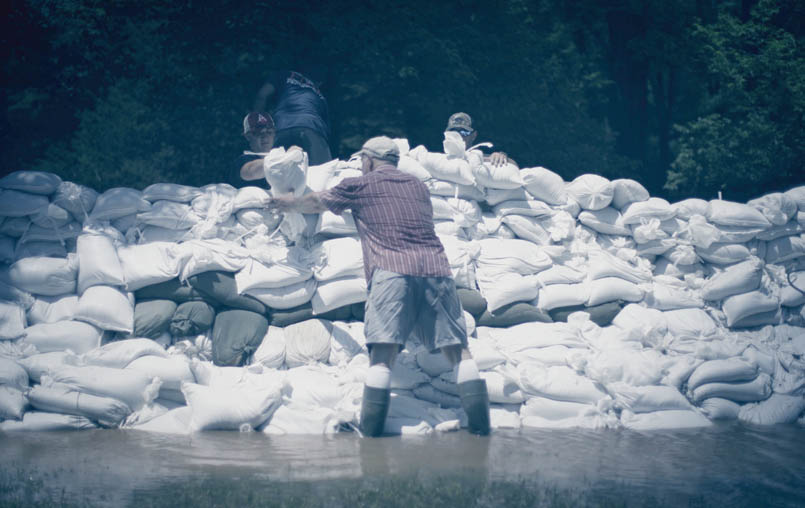20 Jul 2019 ‘The Rainless Flood’

by Kevin T. Clark
“Oklahoma rains swamp Arkansas homes as the Army Corps of Engineers opens Keystone Dam and releases large amounts of water into the Arkansas River.”
That is the general take on the headlines designed to warn us of what is coming. It is going to be a 100-year flood — some say 500-year. We are being told to get ready. Yet, the skies are clear. Even the forecast is clear.
I’ve been making documentary films for about 20 years. Most are historical films: the state’s history seen through the lens of the Arkansas Gazette; the life of an underappreciated Brinkley, Ark., musician (some folks call him the grandfather of rock ‘n’ roll); an unsolved murder from the mid-1970s and more. History, generally, waits for you. It waits on the pages and in the microfilm.
The past few years, though, after landing at public television with AETN in Conway, I’ve been challenged to cover stories contemporaneously.
With this new challenge, the stories move and change. Things that seemingly mean nothing develop, and a lead that you think hints at a great story sometimes falls flat. It is frustratingly invigorating. I love it.
This time, water is coming, and I gear up to capture it — as does nearly every other journalist in the state. My media colleagues do a wonderful job covering things like this: live shots, deadlines. Their pace is frenetic, and they’re built for this.
AETN is not a news station. We don’t have a daily newscast or a team of reporters on the ready. It is tempting to see that as a weakness, but it isn’t. Without a 10 p.m. deadline or the need to find tomorrow’s new story, we can go deeper. If we can just find the right situation, the people who will let us in, we can really tell a compelling story.
When I stumble into Treasure Hills subdivision, I don’t realize it, but I’ve just met some friends. Brian and Trina Hargett’s home buzzes with activity. Floodwaters are approaching their home, and, while they have sandbags, the water is rising. They need more — and quickly.
When I briefly speak with Brian, he says that they had just moved into the neighborhood. They haven’t even met their neighbors, yet. There are about 15 people helping him expand his wall, and he had never met most of them. His camera-shy wife, Trina, mentions they had just gotten married — less than a month ago.
About 100 yards east of the Hargett home is the Johnson’s. It was hard not to notice the substantial wall Paul Johnson and his wife, Linda, had built. He built it early and high.
Paul is chatting with neighbors when I introduce myself. He says the water is expected to get about halfway up his wall, but it is not even close yet. Could the forecasts have been wrong? He’s feeling a little guilty. Some of his neighbor’s homes have already been overtaken by the water. “Those sandbags could have gone to another family,” his voice crackles with emotion. “God bless them all.”
Thursday evening, as I plan Friday’s schedule and look at some of the footage from Treasure Hills, I think, “Maybe this is our story,” but I have to make a decision. Should I expand coverage and head up to Fort Smith or embed in Treasure Hills? With Paul’s emotional voice still ringing in my head and Brian and Trina’s extended, damp honeymoon, my gut is telling me to stay at Treasure Hills. That evening, all the local news stations had multiple packages covering Fort Smith, Russellville and more, right now. More or less, I have Treasure Hills to myself. I decide that it’s my story.
Friday morning, the fight is on. At the Hargett place, the water is winning. The home is surrounded, and the wall was giving way. But pumps have arrived, and a small army of family and volunteers works intensely to keep the water out. Sandbags are loaded onto boats to fortify the existing wall. Not only do they have to build the wall higher, but wider, too: build out and, then, up.
Over at the Johnson’s place, any guilt Paul may have had about using too many sandbags is assuaged. The water has him surrounded, too. Neighbors are manning the wall, checking for leaks and pumping out any water that seeps in. Over the coming hours, their wall will be tested, as well.
Watching all this — families, friends and strangers struggle together to save these homes — I know this is it. This is where I needed to be. The entire experience is dramatic and compelling, so much so that, at times, it is hard not to put the camera down and help. I do my best to stay out of the way but capture as much as I can.
Trina did her best to avoid my camera but did so in a way that made me feel that a gentle persistence would win her over. It does. That is the tack with stories like this: gentle persistence. Stay back out of the way but capture what you can to tell the story. After a while, you become part of the scene or, better yet, part of the family. In fact, as I type this, the waters have fully receded. and I’ve been invited over to the Johnson’s for dinner.











